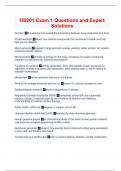HS201 Exam 1 Questions and Expert Solutions Nutrition ✅the science that studies the interactions between living organisms and food Phytochemicals ✅Need - non-nutritive compounds that contribute to health and may fight chronic disease Macronutrients ✅needed in large amounts; energy -yielding; carbs, protein, fat; organic (meaning contain carbon) Micronutrients ✅provide no energy for the body; necessary for proper functioning; required in small amounts; vitamins and minerals Functions of nutrients ✅energy generation, form and maintain shape and structure, regulation of body processes and metabolism, each nutrient plays a role in helping to maintain homeostasis Metabolism ✅all the reactions that occur in the body What is the average american diet low in? ✅vitamin D, calcium, potassium, fiber Epidemiological research ✅study of populations of people Registered Dietitian Nutritionist (RDN) ✅completed at least BA and supervised practice; passed a national exam by the Academy of Nutrition and Dietetics; understanding of medical nutrition therapy Public health nutritionist ✅degree in nutrition; not an RD Licensed dietitian nutritionist (LDN) ✅licensed by state licensing agencies Human genome project ✅an international study of the entire human genetic material; now know the complete sequencing of DNA in cells Nutritional genomics ✅study of how specific food components affect gene expression in your cells and thereby your health Components of a healthy diet ✅high in nutrient density, balance, variety, moderation Nutrient density ✅a measure of the nutrient a food provides compared to its energy content Dietary Reference Intakes ( dris) ✅reference values used for planning and assessing the diets of healthy people on an average daily basis; issued by IOM; goals: prevent deficiencies, decrease incidence of chronic disease and promote health Estimated Average Requirement (EAR) ✅intake that meets the estimated nutrient needs of 50% of individuals in a sex and life -stage group; starting point Recommended Dietary Allowance (RDA) ✅intakes that are sufficient to meet the nutrient needs of 97 -98% of healthy individuals; risk of deficiency is low here Adequate Intake (AI) ✅goal when not enough data to determine RDA or EAR; based on observed or experimentally determined approximations of the average nutrient intake by a healthy population; never have both AI or RDA; intake at or above AI is unlikely to be deficient Tolerable Upper Intake Level (UL) ✅maximum daily intake that is unlikely to pose a risk of adverse health effects; helps prevent nutrient toxicities; specific to life stage and sex Estimated Energy Requirement (EER) ✅average energy intake values predicted to maintain a healthy weight in healthy individuals; based on gender, age, height, weight, physical activity Acceptable macronutrient distribution ranges ( amdrs ) ✅ranges of intake for energy -
yielding nutrients; expressed as % of total energy intake (Carbs - 45-65%, fat - 20-35%, protein - 10-35%) A healthy eating pattern limits: ✅sodium (<2,300 mg), saturated fat (<10% kcal), trans fat, added sugars (<10% kcal), alcohol FDA mandated food label requirements: ✅name of the food, net weight, name and address of manufacturer, list of ingredients in descending order by weight, nutrition facts panel Nutrient content claims ✅describe the level or amount of a nutrient in food product Health claims ✅describe a relationship between a food or dietary compound and a disease or health -related condition Structure /function claims ✅describe how a nutrient or dietary compound affects the structure or function of the human body Zoochemicals ✅compounds in animal food products that benefit health Digestion ✅a multi -step process of breaking down foods into absorbable components using mechanical and chemical means in the gastrointestinal (GI) tract What does the GI tract consist of? ✅mouth, esophagus, stomach, small and large intestines and rectum, accessory organs (liver, pancreas, gallbladder) What are the processes after digestion? ✅nutrients are absorbed through the walls of the into two transport systems: circulatory system, lymph system -> sent to the liver for processing before delivery to cells What does the stomach do? ✅mechanical digestion, begins protein breakdown, produces intrinsic factor for digestion of vitamin B12 Things that leave the stomach faster? ✅liquids, carbs, low -fiber, low -kcal foods Things that leave the stomach slower? ✅fats, proteins, high fiber foods Small intestine ✅most digestion - mechanical and chemical, long (23 ft), narrow, coiled, contains villi to increase surface area for absorption Large intestine ✅most nutrients have been absorbed before reaching here, absorbs water and electrolytes, bacteria produce vitamin K and biotin, break down fiber and undigested carbs, eliminates waste What does complete digestion of chyme requires? ✅enzymes, hormones Enzymes ✅secreted by stomach, small intestine, pancreas Break down food into absorbable nutrient components Hormones ✅control digestive secretions and regulate enzymes Liver ✅produces bile, metabolism of carbs, fats, protein, stores nutrients (vitamins A, D, B12, E, copper, iron, glycogen), detoxifies Gallbladder ✅concentrates and stores bile - released when fat is ingested, breaks down fat into smaller molecules The pancreas produces.. ✅bicarbonate, hormones (insulin, glucagon), digestive enzymes that help break down carbs, protein, and lipids




